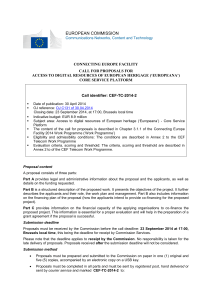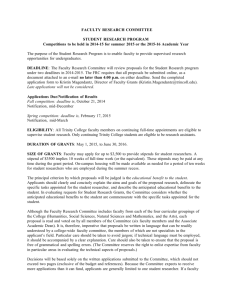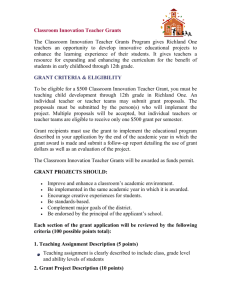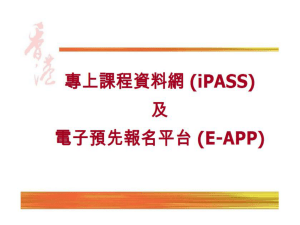docx - Europa
advertisement
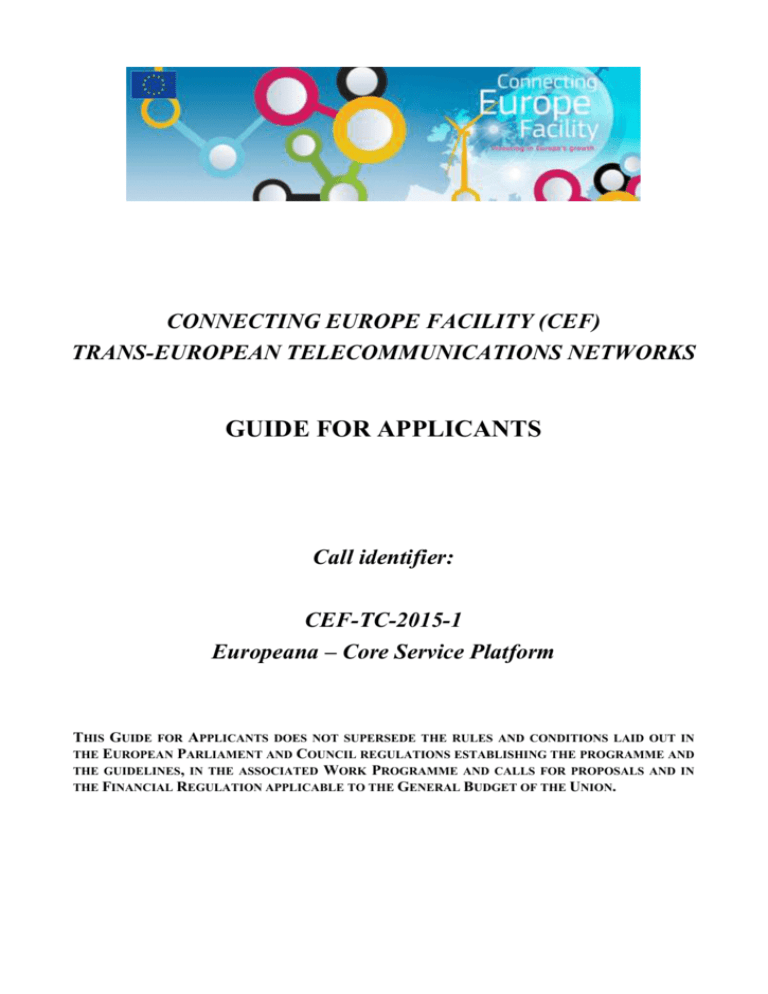
CONNECTING EUROPE FACILITY (CEF) TRANS-EUROPEAN TELECOMMUNICATIONS NETWORKS GUIDE FOR APPLICANTS Call identifier: CEF-TC-2015-1 Europeana – Core Service Platform THIS GUIDE FOR APPLICANTS DOES NOT SUPERSEDE THE RULES AND CONDITIONS LAID OUT IN THE EUROPEAN PARLIAMENT AND COUNCIL REGULATIONS ESTABLISHING THE PROGRAMME AND THE GUIDELINES, IN THE ASSOCIATED WORK PROGRAMME AND CALLS FOR PROPOSALS AND IN THE FINANCIAL REGULATION APPLICABLE TO THE GENERAL BUDGET OF THE UNION. Introduction The Guide for applicants is part of the information necessary to make a project proposal in response to calls for proposals under the Connecting Europe Facility Telecommunications sector. It provides guidance on how to submit a proposal. It is accompanied by an appendix which contains the proposal submission forms (Parts A, B and C). Additional Information The additional documents you will need to prepare a proposal are: 1. Regulation (EU) No 1316/2013 of the European Parliament and of the Council of 11 December 20131 establishing the Connecting Europe Facility (CEF) 2. Regulation (EU) No 283/2014 of the European Parliament and of the Council of 11 March 20142 on guidelines for trans-European networks in the area of telecommunications infrastructure (the CEF Telecom guidelines) 3. The Work Programme for 2015 as amended which provides the description of the actions, the means to implement the programme and the evaluation criteria. 4. The Call for Proposals for 2015, as published on the programme website, detailing which actions are open under a given call and the deadline for proposal submission. 5. The Guidance Notes on Evaluation providing guidelines for experts evaluating proposals received in response to the 2015 call for proposals. Potential applicants may wish to read them for an overview of the evaluation process. 6. The Model Grant Agreement with annexes, which specifies the terms and conditions to which your consortium will be expected to agree if your proposal is selected for funding. All the above documents are available for downloading from the INEA website at https://ec.europa.eu/inea/en/connecting-europe-facility/cef-telecom/apply-funding/2015-cef-telecom-calleuropeana or can be obtained from this address: European Commission Directorate-General for Communications Networks, Content and Technology Office EUFO 1178 (Europeana) L-2920 Luxembourg E-mail: INEA-CEF-Telecom-Calls@ec.europa.eu The personal data collected in the context of the call for proposals will be processed in accordance with the Regulation (EC) No 45/2001 of the European Parliament and of the Council of 18 December 2000 on the protection of individuals with regard to the processing of personal data by the Community institutions and bodies and on the free movement of such data (OJ L8, 12.01.2001, p.1). 1 OJ L 348, 20.12.2013 2 OJ L 86, 21.3.2014 2 Table of Contents I. PROGRAMME OBJECTIVES ................................................................................................................... 4 II. CEF TELECOMMUNICATIONS CALL FOR PROPOSALS IN 2015.................................................. 4 III. PARTICIPATION ........................................................................................................................................ 4 IV. PREPARATION AND SUBMISSION ........................................................................................................ 4 IV.1. IV.2. IV.3. IV.4. IV.5. IV.6. IV.7. IV.8. PROPOSAL STRUCTURE ..................................................................................................................................... 4 PROPOSAL FORMS ............................................................................................................................................. 5 OPERATIONAL AND FINANCIAL CAPACITY ........................................................................................................ 5 LANGUAGE ....................................................................................................................................................... 5 APPLICANTS’ AGREEMENT................................................................................................................................ 5 SUBMISSION DEADLINE .................................................................................................................................... 6 SUBMISSION METHOD ....................................................................................................................................... 6 CHECK LIST FOR PROPOSALS ............................................................................................................................ 8 V. EVALUATION OF PROPOSALS .............................................................................................................. 9 VI. GRANT AGREEMENT PREPARATION ................................................................................................. 9 VI.1. GRANT AGREEMENT SIGNATURE AND ENTRY INTO FORCE ............................................................................... 9 VI.2. CONSORTIUM STRUCTURE .............................................................................................................................. 10 VI.2.1. The coordination of the project ............................................................................................................ 10 VI.2.2. Technical collective responsibility ....................................................................................................... 10 VI.2.3. Financial joint responsibility ............................................................................................................... 10 VI.3. FINANCIAL CONTRIBUTION OF THE UNION ..................................................................................................... 11 VI.3.1. Eligible project costs ............................................................................................................................ 11 VII. VII.1. VII.2. VII.3. VII.4. VII.5. ASSISTANCE TO APPLICANTS ............................................................................................................ 12 INFORMATION DAYS ....................................................................................................................................... 12 CEF-TC HELPDESK ........................................................................................................................................ 12 PRE-PROPOSAL SERVICE ................................................................................................................................. 12 REDRESS PROCEDURE ..................................................................................................................................... 12 SOME RECOMMENDATIONS ............................................................................................................................. 13 APPENDICES PART A: PART B: PART C: PART D: FORMS A1-A4 TECHNICAL ANNEX FINANCIAL VIABILITY FORMS GUIDANCE NOTES ON EVALUATION I. Programme objectives The objectives of EU action as regards trans-European telecommunications networks for 2014 are outlined in the CEF Telecom guidelines. Article 3 thereof defines the specific objectives as pursuing: – Economic growth and support to the completion and functioning of the internal market in support of the competitiveness of the European economy, including small and medium-sized enterprises (SMEs). – Improvements in daily life for citizens, businesses and administrations at every level through promotion and interoperability. II. CEF Telecommunications Call for proposals in 2015 Two calls for proposals, with a fixed deadline, are foreseen for 2015. This Guide refers exclusively to the call for proposals in support of the Europeana Core Service Platform, one of the subject areas covered by CEF-TC-2015-1. The financial assistance will be grants to projects. All such grants need to be co-financed by the beneficiaries, who will need to demonstrate in the proposal their contribution to the project. III. Participation Proposals must be submitted by one or more Member States or, with the agreement of the Member States concerned, by international organisations, joint undertakings, or public or private undertakings or bodies established in Member States. Proposals may be submitted by entities which do not have legal personality under the applicable national law, provided that their representatives have the capacity to undertake legal obligations on their behalf and offer a guarantee for the protection of the Union’s financial interests equivalent to that offered by legal persons. Proposals submitted by natural persons will not be eligible. Where necessary to achieve the objectives of a given project of common interest and where duly motivated, third countries and entities established in third countries may participate in actions contributing to the projects of common interest. They may not receive funding under CEF, except where it is indispensable to achieve the objectives of a given project of common interest. IV. Preparation and submission IV.1. Proposal structure A proposal consists of three parts: Part A provides legal and administrative information about the proposal and the applicants, as well as details on the funding requested. Part B is a structured description of the proposed work. It presents the objectives of the project. It further describes the applicants and their role, the work plan and management. Part B also includes information on the financing plan of the proposal (how the applicants intend to provide co-financing for the proposed project). 4 Part C provides information on the financial capacity of the applying organisations to co-finance the proposed project. This information is essential for a proper evaluation and will help in the preparation of a grant agreement if the proposal is successful. IV.2. Proposal forms The forms and layout instructions are included in the Appendix – Parts A, B and C. Please read the instructions in each part of the proposal forms carefully. For instance, the legal name and the legal address of an applicant must correspond exactly to the name and address occurring in e.g. national company registers for companies and in national laws/by laws/statutes for universities. Applicants must indicate the proposal short title (acronym 3) at the top of every page of part B and all annexes. Pages must be numbered. IV.3. Operational and financial capacity Applicants must demonstrate that they have the financial and operational capacity to successfully complete the proposed project. The organisation’s accounts as requested in part C and the curricula vitae of key personnel as requested in part B are hence key input for the application of the award and selection criteria (see Guidance Notes on Evaluation4), whilst further information may be requested by the Commission at a later stage. Public bodies are exempted from the verification of financial capacity. IV.4. Language Proposals may be submitted in any official language of the European Union. In order to facilitate assessment by outside experts, however, applicants intending to submit a proposal in a language other than English are kindly invited to add an English translation of at least the narrative part of the proposal (part B, see below). IV.5. Applicants’ agreement When submitting a proposal on behalf of the consortium members, in Form A1 (see Appendix Part A) the coordinator declares that it is acting on behalf of all applicants, all of whom - are aware of this proposal - agree with its content and submission - have the necessary internal authorisations to commit their organisation to submitting this proposal - applicants that are Member States or international organisations are required to fill Form A2b (a section of Form A) to report on the public or private undertakings or body(ies) which will implement the action. - are aware that the proposed project may receive only one grant from the EU budget. 3 The applicants shall bear sole responsibility for assessing that the use of acronyms does not infringe existing trademarks, registered patents and other similar rights. 4 As Parts A, B, C, the Guidance Notes on Evaluation are also in Appendix to this Guide. 5 The European Commission reserves the right in case of non-compliance with these conditions to eliminate this proposal from the evaluation and/or Grant Agreement preparation process at any time. IV.6. Submission deadline Proposals must be received by the Commission before the call deadline specified in the call text. The deadline is published in the call for proposals and in the Official Journal of the European Union. Please note that the deadline applies to receipt by the Commission. No responsibility is taken for the late delivery of proposals. Proposals received after the submission deadline will not be considered. IV.7. Submission method Proposals must be prepared and submitted to the Commission on paper in one (1) original and five (5) copies, accompanied by an electronic copy on USB key. Proposals must be completed in all parts and must be sent by registered post, hand delivered or sent by courier service. Proposals submitted by fax, telex, or e-mail will not be accepted. Proposals submitted to the Commission will not be returned. Filling in the Forms The templates of the forms can be downloaded from the call for proposals website: https://ec.europa.eu/inea/en/connecting-europe-facility/cef-telecom/apply-funding/2015-ceftelecom-call-europeana. The forms will be machine-read at the Commission. To avoid misreading of your proposal details, we would kindly ask you to read and follow the notes below. - Print the A and C forms directly from the provided Excel files. For numbers, please round to the nearest integer. Do not insert any character or space to separate the digits in a number. Remember to indicate the proposal acronym on all pages of the proposal. All costs must be given in EUR (and not kilo EUR) and shall include value-added tax (VAT) in accordance with art. 126.3 (c) of the Financial Regulation. Packaging and Delivery Proposals should be prepared and submitted as follows: - one complete unbound original of all parts five bound copies of all parts - USB key with the electronic version of the proposal containing all administrative forms in excel format and the Description of Work in PDF format. o One Excel file named "sip_forms_A1_A3_coordinator.xls" containing A1 and A3 forms to be prepared only for the coordinator. Please make sure that in the form A3 (budget table), the applicant number and the Organisation short name match the A2 forms provided by each applicant. 6 o One Excel file for each applicant (coordinator included) created from “sip_forms_applicant_XX.xls” containing A2, A4, C1 and C2 forms, to be named as: ”sip_forms_applicant_01.xls” (the coordinator is always applicant number one) ”sip_forms_applicant_02.xls” etc. (Please make sure to use the same numbering for all applicants in the A2 and A3 forms, which are completed by the coordinator. o 1 PDF containing part B with the description of work named as “[project acronym]_part_B.pdf” A package should contain only one proposal with the original, the respective copies and the USB key. If you wish to submit more than one proposal, please send each proposal in a separate package. Each proposal should be sent to the address of the European Commission specified in the call notice and marked: CEF-TC-2015-1 – Europeana core service platform Once a proposal has been received and registered by the Commission, an acknowledgement of receipt will be dispatched. 7 IV.8. Check list for proposals Experience shows that a number of general checks are useful before submitting a proposal: Action Completed Are all parts of the proposal complete? Part A: Form for each applicant Part B: Narrative description of work Part C: Financial Capacity Check Information Have you prepared one unbound original of all parts? Have you prepared five bound copies of all parts? Is the USB key with the electronic versions complete? 1 Excel file called "Form A" for each applicant (coordinator included) 1 PDF containing part B with the narrative description of work named as “[project acronym]_part_B.pdf” Have you addressed the proposal to the Commission address specified in the call notice and marked it "CEF Telecom – CEF-TC-2015-1 - Europeana core service platform Make sure that your proposal arrives at the Commission by the date and time set in the call notice! 8 V. Evaluation of proposals The evaluation of proposals will be based on the principles of transparency and equality of treatment. It will be carried out by the Commission with the assistance of independent experts. All proposals will be treated in strict confidence. Each submission will be assessed on the basis of the evaluation criteria divided into: eligibility, exclusion, selection and award criteria. Only proposals meeting the requirements of the eligibility and exclusion criteria shall be evaluated further. The description of the evaluation criteria is presented in the Work Programme. Details of the evaluation process are given in the Guidance Notes on Evaluation. Additional administrative and financial information might be required to assess the viability of the proposed project as the applicants will have to demonstrate that they have all the human, financial and technical resources required for carrying out the project. As a general rule, public sector bodies are considered to be financially viable. In all other cases (including e.g. companies, associations and non-governmental non-profit bodies), the financial viability of the applicants will be assessed and the Commission may seek to safeguard its interest by asking for a bank guarantee or other suitable measures. VI. Grant Agreement Preparation Grant Agreement preparations are aimed at offering grant agreements to the successfully retained projects. The basic model grant agreement is not negotiable. Applicants are invited to read this document and its annexes carefully, especially the General Conditions, before agreeing to submit a proposal. The model grant agreement can be downloaded from the call page at https://ec.europa.eu/inea/en/connecting-europe-facility/cef-telecom/apply-funding/2015-cef-telecom-calleuropeana. Grant Agreement preparations will cover technical, legal or financial as well as other relevant aspects of the proposal, based on the results of the evaluation. The technical aspects of Grant Agreement preparations may cover revisions to the proposed project work plan and adjustments to it, resulting from the evaluation. The legal aspects would cover review of any special contractual clauses or conditions required for the project, and other aspects relating to the development of the final grant agreement (including project start date, timing of deliverables - in particular certificates on financial statements and other legal requirements). The financial aspects would cover the total budget and the EC contribution, the amount of the initial prefinancing, timing of reporting and payments and, if necessary, any financial guarantee which may be requested by the Commission. If it proves impossible to reach agreement with any applicants within a reasonable deadline that the Commission may impose, the grant agreement preparation phase may be terminated and the proposal will be rejected by the Commission. VI.1. Grant Agreement signature and entry into force The grant agreement will be sent to the coordinator of the project for signature and will enter into force following its signature also by the Commission. The other beneficiaries will have only to complete and sign the accession form – “Consent of the beneficiaries to accede to the agreement”. This form will be then transmitted to the Commission by the coordinator by the date specified in the grant agreement. 9 The project will start on the date agreed upon during Grant Agreement preparations. The table below gives an overview of the process from proposal stage to grant agreement signature: Proposal submission Eligibility checks Evaluation of eligible proposals by the Evaluation committee (with the assistance of independent experts) Drawing up priority lists of proposals suitable for funding (short-listed and reserve-listed proposals if applicable) and drafting of implementation plan. Grant agreement preparation with successful proposal Grant agreement signed (~3 months after notification and opening of Grant Agreement preparations) Project starts on the date specified in the grant agreement VI.2. Consortium structure Applicants should read carefully the model grant agreement and its annexes. The following points are relevant to the structure of the proposal. VI.2.1. The coordination of the project Within a consortium, applicants shall designate one of the applicants to carry out the coordination function. The coordinator is the liaison between the beneficiaries and the Commission, responsible e.g. for collecting, integrating and submitting project deliverables, and for distributing the funds received from the Commission. It should be noted that the successful management of the project is a joint commitment of all the applicants. Sufficient resources must be allocated to the coordination and management of the project. VI.2.2. Technical collective responsibility As laid down in the model grant agreement the technical implementation of the project will be the collective responsibility of the beneficiaries. To that end, each beneficiary shall take all necessary and reasonable measures to attain the objectives of the project, and to carry out the work incumbent on a defaulting beneficiary. VI.2.3. Financial joint responsibility The Financial responsibility of the beneficiaries is laid down in the grant agreement. 10 VI.3. Financial contribution of the Union The Commission provides a financial contribution to the actual eligible costs incurred for execution of the project work for which a grant has been awarded. The detailed provisions regarding eligible costs are laid down in the Grant Agreement. VI.3.1. Eligible project costs Beneficiaries are required to identify and declare their eligible costs by the submission of financial statement based on the actual costs incurred in the execution of the action. Supporting documents, which justify these costs, must be retained for a period of 5 years (3 in case of low value grants – grants below the threshold of 60,000.00€) starting from the date of payment of the balance. A cost shall be considered as eligible only where it is necessary for and has occurred during the project life and is provided for in the grant agreement. It shall be reimbursed if the amount has actually been spent and recorded in the accounts. No profit may be included. The different categories of project-related costs that are eligible for Commission funding are the following: Direct Costs Direct costs are all those costs which can be attributed directly to the project and are identified by the beneficiary as such, in accordance with its accounting principles and its usual internal rules. The following categories of costs may be claimed as eligible direct costs, provided that they satisfy the conditions of eligibility set out in the grant agreement: ‒ Personnel costs: personnel directly carrying out work under the project; time devoted to the project shall be recorded. ‒ Travel and subsistence: The real costs reflected by the actual amounts spent for travel and subsistence costs of the personnel working for the project are eligible costs. ‒ Depreciation costs of equipment or other assets: The depreciation costs, or the cost of rental or lease of equipment and other assets, as recorded in the accounting statements of the beneficiary, covering the period for which the project runs and applying the rate of use for the project, are eligible costs. ‒ Costs entailed by service contracts: Applicants must be able to carry out the proposed work to be performed. However, where it is necessary to subcontract certain elements of the work, this should be clearly identified in part B of the proposal. Any subcontract must meet the requirements of the grant agreement If you make a proposal which involves sub-contracting, you must explain: o What tasks will be subcontracted and the reasons why. o How you plan to select the potential subcontractor in accordance with the provisions of the grant agreement (transparency, equal treatment and best value for money). o The basis on which the estimated cost of sub-contracting has been calculated. ‒ Other specific costs: Costs arising directly from requirements imposed by the grant agreement, provided that they are directly assigned to the action and they are not already accounted for under the indirect costs category may be eligible costs. Indirect Costs Indirect costs of the action are those costs which are not specific costs directly linked to the implementation of the action and can therefore not be attributed directly to it. They may not include any costs identifiable or declared as eligible direct costs. 11 Eligible indirect costs shall be declared on the basis of a flat rate of 7% of the total eligible direct costs minus subcontracting costs. VII. Assistance to applicants VII.1. Information days No information days will be organised for this area of the call. VII.2. CEF-TC Helpdesk Any questions concerning the call not covered in this document or in the material available at the programme website may be directed to the Helpdesk: Email: INEA-CEF-Telecom-Calls@ec.europa.eu Any last-minute information concerning the call will be posted on the INEA website, which potential applicants should check periodically. VII.3. Pre-proposal service A pre-proposal service is available through the helpdesk. Applicants are advised to use the preproposal form available from the INEA website and to submit a completed pre-proposal form early in the proposal development process in order to make the most efficient use of EC feedback. The Commission will give comments as quickly as possible. Please note, however, that the Commission comments are indicative and not binding. They do not pre-empt the evaluation of any subsequent full proposal. VII.4. Redress procedure If, following receipt of the information letter with the results of the evaluation, as summarised in the Evaluation Summary report (ESR), the coordinator believes there have been shortcomings in the handling of his or her proposal, and that these shortcomings have jeopardised the outcome of the evaluation process, the redress procedure can be used. Within one month from the date of dispatch of the Commission's letter, the co-ordinator should submit a complaint following from instructions given in the ESR. An internal evaluation review committee ("redress committee") will then be convened to examine those cases that have been submitted by co-ordinators, before the deadline mentioned above. Complaints that do not meet these conditions, or do not deal with the evaluation or eligibility checking of a specific proposal, will not be considered. The redress procedure will not result in a reevaluation of the technical content by the redress committee. An initial reply will be sent to complainants no later than one month of the deadline for redress requests, mentioned above. This initial reply will indicate when a definitive reply will be provided. The redress procedure does not replace other channels applying to Commission actions, such as: the Secretariat-General of the Commission for breach of the code of good administration (relations with the public); the European Ombudsman for “maladministration” or the European Court of Justice for a decision affecting a person or legal entity. These channels are also available to applicants who wish to register a complaint after the deadline mentioned above. 12 VII.5. Some recommendations Grant agreement: Read the model grant agreement and check that the conditions in it are acceptable for the organisations in your consortium. Presentation: Good proposals are precise and concise providing all the information necessary to convey a comprehensive picture of your project in the proposal documents: neither assumptions, nor external searches (e.g. through links, biographical references etc.) will be made. Follow the format of the Proposal Submission Forms and the template for the description of work for the relevant project type. Evaluators judge on substance, not on number of pages. Common requirements: Check that your proposal fulfils the common requirements for the type of project you intend to submit. Management: Make adequate provisions for high-quality management adapted to the scope of the intended project. Partnership: Applicants should discuss and agree beforehand their respective roles and responsibilities. The consortium should aim at a reasonable distribution of resources and tasks. Competition: There will be competition, and a weak element in an otherwise good proposal might make it lose out to others. Therefore edit your proposal tightly, strengthen or eliminate weak elements. 13
